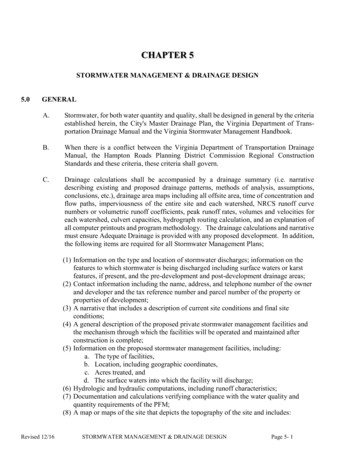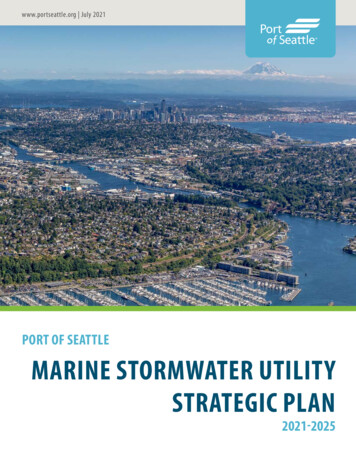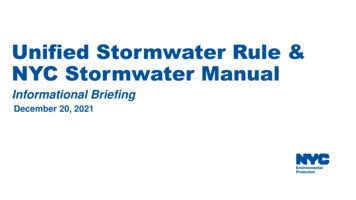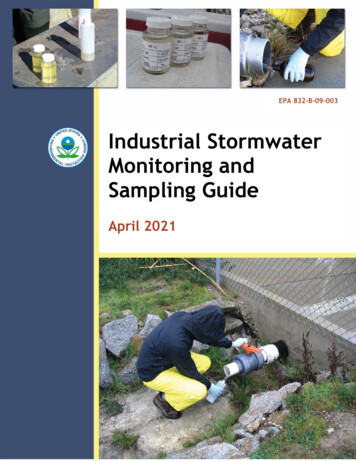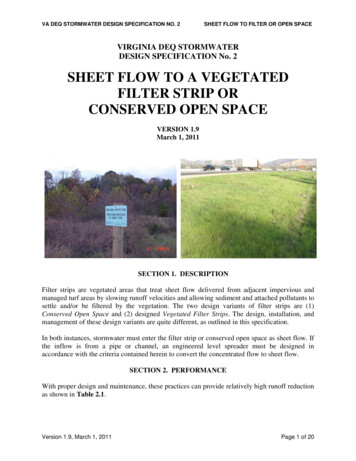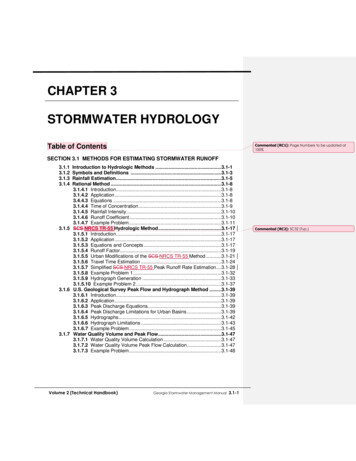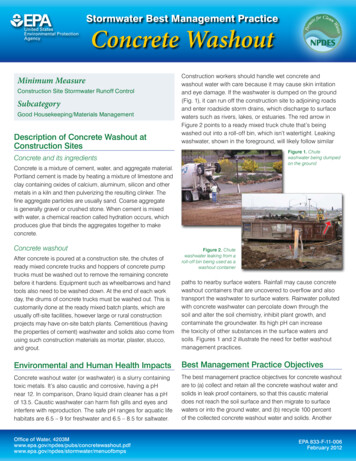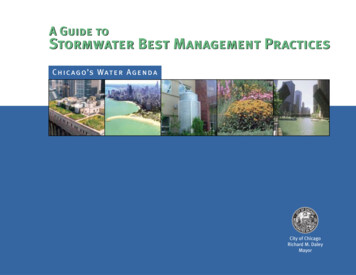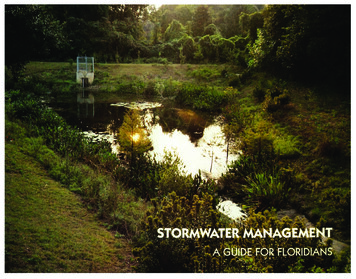
Transcription
STORMWATER MANAGEMENTA GUIDE FOR FLORIDIANSFlorida Department of Environmental RegulationStormwater/Nonpoint Source Management2600 Blair Stone RoadTallahassee, Florida 32399-2400Lawton Chiles, GovernorVirginia B. Wetherell, Secretaryprepared by:Eric H. LivingstonEnvironmental AdministratorEllen McCarronEnvironmental Specialistfunded by:U.S. Environmental Protection AgencyCover Photograph:DER’s Commitment to stormwatermanagement is demonstrated by itsnew wet detention system whichreplaced a traditional drainage system.The preparation and publication of this booklet was fundedin part by a grant from the U.S. Environmental ProtectionAgency through the Nonpoint Source Management Programpursuant to Section 319 of the Federal Clean Water Act.
CONTENTSSTORMWATER MANAGEMENT: A GUIDE FOR FLORIDIANSINTRODUCTION . 5ONE - BACKGROUND . 7A. Hydrological Cycle . 7B. The Watershed . 8C. The River (Lake) System . 9D. The Estuarine System. 9E. The Groundwater System . 11F. The Groundwater-Surface Water-LandConnection . 13TWO - THE STORMWATER PROBLEM . 15A. Effects of Urbanization on Stormwater Quantity . 16B. Effects of Urbanization on Stormwater Quality . 17C. The First Flush . 19THREE - STORMWATER AND WATERSHEDMANAGEMENT. 21A. Stormwater Management . 21B. Watershed Management: The Challenge of theFuture . 22FOUR - PRINCIPLES OF STORMWATERMANAGEMENT. 29FIVE - STORMWATER MANAGEMENT PRACTICES . 33A. BMP Treatment Train . 34B. On-Line vs. Off-Line BMP’s . 35C. The Importance of Vegetation . 37D. Infiltration (Retention) Practices. 38Dry Retention Basins or Areas . 39Grassed Swales . 41Infiltration Trenches . 44E. Detention Practices . 47F. Wetland Stormwater Systems . 53G. Detention with Filtration . 54H. Parking Lots . 55I. Alum Treatment . 57J. Maintenance of Stormwater System . 59SIX - STORMWATER REGULATORY PROGRAMS. 61A. Federal NPDES Stormwater Permitting . 61B. State Stormwater Permitting . 62C. Local Government Stormwater Permitting . 63SEVEN - WHAT LOCAL GOVERNMENTS CAN DO .65A. Develop a Watershed Management Plan .65B. Implementation of the Watershed Plan .66Local Ordinance .66Public Education .66Funding - Stormwater Utilities.68C. Operation and Maintenance of the StormwaterSystem.70D. Intergovernmental Coordination.70CONCLUSION .71INFORMATION SOURCES .72ACKNOWLEDGEMENTS .72
44
INTRODUCTIONWater flowing over the land during and immediately following a rainstorm is called stormwaterrunoff.Stormwater runoff from agricultural lands, fromlands that are undergoing urban developmentand from lands which already are developedcauses significant problems for landowners in itspath, for local governments, and for the waterbodies which ultimately receive it.As a result of stormwater, sediment fills drainageditches and channels, causing flooding. The sediment fills rivers, lakes and estuaries, destroyingwildlife habitat, degrading water quality, and requiring extensive restoration. High stream velocitycauses bank erosion (and more sedimentationdownstream) and loss of valuable habitat andproperty. Areas that once seldom flooded nowflood with regularity. Eroded sites must beregarded. Often, new soil must be brought in toreplace the soil which has washed away.Sediment must be removed – at great cost – fromculverts, storm sewers and navigable waters torestore their capacity. In addition to sediments,stormwater carries nutrients, heavy metals, oils,greases, pathogens and any other materials thataccumulate on the land between rains.This guidebook has been prepared as a sourceof general information on urban stormwatermanagement. It is intended for the fuse of localgovernment officials and others interested insound planning and design of stormwater management systems. It presents general informationon the stormwater problem and how to manageit. Sound planning and good design can createstormwater management systems that are attractive, safe, and efficient, and which provide manydifferent uses and benefits to the community.It is much easier, and much less expensive,to prevent stormwater problems throughproper planning than it is to restore waterbodies and rebuild flooded properties.5
6
CHAPTER ONEBACKGROUNDTHE IMPORTANCE OF WATERWater is Florida’s lifeblood. Whether it is used foragriculture, industry, recreation, or for drinking, anabundance of clean water is essential for Florida’seconomy and our quality of life. Florida’s rapidgrowth, and the vulnerability of its surface andground waters, makes it imperative that its waterresources are managed wisely. Fortunately, theSunshine State receives and abundance of rainfall– 50 to 65 inches from about 120 storms a year.The resulting stormwater, just like treated wastewater, represents a valuable component of ourwater resources to be recovered and reused.A. The Hydrologic CycleIn undeveloped areas, stormwater managementis part of the natural environment. The movementof water through the environment, from theclouds to the earth, and back again, is called theHydrologic Cycle (Figure 1).The cycle begins with the sun’s energy warmingsurface waters, causing evaporation. It continueswhen water vapor rises into the atmosphere, condenses to form clouds, then falls to earth as rainor snow.When water reaches the ground, it can take threemain paths: it can run off the land and collect inthe wetlands, lakes and rivers that eventually flowto the sea; it can infiltrate through the soil, recharging the ground water, or it may be absorbedinto the topsoil to be used by plants and eventually returned to the atmosphere through evapotranspiration, which is the evaporation of waterfrom land surfaces plus transpiration, the watergiven off by the roots and leaves of plants.Of course, this is a simplified explanation of avery complex natural system – a system that inundeveloped areas maintains a dynamic balance.Natural stormwater systems are in constantchange: streams change course, natural erosionoccurs, and vegetation and soil permeabilitychange with the seasons. the natural system isthrown out of balance by man-made changes tothe land.The effect of water moving through Florida’s diverse water system can differ greatly dependingon whether the receiving water is a river, lake,estuary or ground water system. Additionally,Florida’s water systems often are interconnected—surface waters become ground waterswhich can eventually flow back to surface water.A brief discussion of Florida’s various water systems follows to provide a basic introduction tothese complex, interrelated systems.7
B. The WatershedA watershed (or drainage basin) is the geographicarea from which water in a particular stream, lakeor estuary originates (Figure 2). All lands in thewatershed drain toward the stream, lake or bayand contribute pollutants to these waters. It isimportant to recognize the connection betweenour activities on the land within a watershed andthe ground water and surface water that flowsthrough it. Everything we do on the land within thewatershed ultimately will have an effect on the8water resources of that watershed. It is for thisreason that we must begin to manage our land andwater resources in a comprehensive, coordinated manner through Watershed Management. Watershed management is the integrationof land use, infrastructure and water resourcesthroughout an entire watershed.Watershed boundaries rarely correspond to localgovernment boundaries. As a result, coor-dination and cooperation among local andregional governments, state government and theprivate sector is essential for effective watermanagement. If one community limits pollutantsor manages its stormwater but others within thewatershed do not, then flooding and waterquality problems can still result. Those who jointhe Watershed Management Team can worktogether and effectively solve problems and mangethe resources within a watershed.
C. The River (Lake) SystemThe characteristics of water and its effects on dailylife can be best understood by studying the riveror lake basin in which a community is located.For instance, a small creek running through aneighborhood may appear to be unrelated to thestream that crosses another part of town, butthey can be connected. Creeks join to createlarger streams, which in turn form still larger onesin a natural drainage network that carries rainwater off backyards, fields, and streets and intorivers or lakes or estuaries. Without this naturalstormwater system, land would stay wet orflooded.As water circulates through a river system it cancarry pollutants to downstream parts of thewatershed. This is why lakefront or coastal residents may be concerned about the activitiesof people living some distance upstream fromthem. Although many miles apart, they all livewithin the same watershed, and so can affect oneanother through their various uses of land andwater.D. The Estuarine SystemCoastal estuaries have been called the cradle oflife. They are the bodies of water where freshand salty water mix, producing a nutrient-richhabitat for plants, animals and fish. Florida’sestuarine system, the largest in the United States,encompasses three million acres of tidal streams,wetlands, bays and lagoons. Estuaries are one ofthe most productive natural systems on earth. InFlorida, they account for more than seventy percent of the recreational and important commercial fish and shellfish.Florida has a wide variety of estuaries, rangingfrom tidal rivers like the St. Johns River, secludedlagoons like the Indian River lagoon, tropical bayslike Florida and Biscayne Bays, and shallow basinsbehind barrier islands like Apalachicola Bay andSanta Rosa Sound. All of these estuaries havedifferent salinity patterns, tides, marine life, sediment types and shorelines. The conditions withinestuaries are continually changing so the organisms that live in them must be adaptable. Thecombination of changing salinity, temperatures,and tides, together with shallow water and marchgrasses, provides physical protection and abundant food for juvenile fish and shellfish that useestuaries as nursery areas.The very functions that make estuaries productivealso make them vulnerable to pollutants instormwater. Just as estuaries efficiently trap andrecycle the nutrients that support the estuarinefood web, they can also trap and concentratepollutants. Estuaries can be hurt by too muchfresh water, the possible result of urbanizationand the increase in stormwater runoff in theestuarine watershed.9
10
E. The Ground Water SystemWhen water seeps into the ground it is eitherabsorbed by the plants and soil or passesthrough the soil to become part of the groundwater supply. More than 90% of Florida’s residents depend on ground water for their drinkingwater. The sand, gravel and rocks that allowwater to collect and move through them arecalled aquifers.The water level in an unconfined or “watertable” aquifer will rise and fall depending uponthe amount of water stored in the ground. Therecharge of this aquifer occurs by seepagethrough porous soils when it rains. Althoughthis type of aquifer will recharge relatively easily, pollutants can seep into it just as easily.A second type of aquifer is called a confinedaquifer. It consists of layers of various types ofrock (generally limestone in Florida) and clay.The water in this aquifer moves through theearth under pressure rather than simply bygravity. Recharge to the confined aquifer takesplace only in certain areas (recharge zones), soit is less likely to get polluted, unless pollutionsources are located in the recharge zones.The dynamics of ground water movement arecomplicated. In essence, ground water movesdownward, following the slope of the watertable (not the land surface) from its highestlevel to its lowest. The water slowly filters between the rocks and soil of an aquifer, usuallyat a rate of a few inches a day. This slowmovement keeps pollutants from being quicklydiluted. Therefore, a well located down-slopefrom a source of pollution could be contaminated by the ground water flow that still contains concentrated pollutants.The permeability of soil overlaying an aquifercan also affect pollution. For example, the siting of septic tanks or retention ponds in areaswhere the water table lies just below verysandy soil can create problems. The poroussand does not retain pollutants as long asother soils do and it lacks the organic material and microbes that can trap and degradesome pollutants. Areas of Florida with karstgeology-land with numerous sinkholes andwith underground flow through large cavitiesin the limestone-are also highly susceptible toground water contamination, even from stormwater management systems.11
12
F. The Ground Water-Surface Water-LandConnectionTo maintain the quality of our lakes, rivers andestuaries, we must recognize the connection between ground waters and surface waters. In manycases, ground water eventually flows into ariver, lake or estuary (Figure 3) or even becomessurface water such as a spring. Although someof the pollutants in degraded ground water maybe dispersed as the water flows through theaquifer, some pollutants still reach surface waterbodies. Movement of contaminated surface water ground water can also occur by percolation of pollutants from surface impoundments(e.g., pits, ponds, lagoons) into the aquiferunderneath. not only can ground water contamination affect lakes, rivers and estuaries but it isalso possible for estuarine waters to flow backinto the underlying aquifer. An example of this issalt water intrusion such as has occurred in DadeCounty where uncontrolled canal drainagecaused declines in fresh water levels allowingsalt water to gradually migrate inland.Little River Springs creates a stream which flows into the Suwannee River and on to the Gulf.13
14
CHAPTER TWOTHE STORMWATERPROBLEMThe volume of stormwater generated by a rainstorm depends upon the total amount of rainfall,except that lost by infiltration, transpiration,evaporation, and surface storage. The amount ofthese losses is a function of climate, soils, geology, topography, vegetative cover and, mostimportantly, land use.Changes in land use affect the hydrology of anarea in four ways: changes in peak flow charac-teristics of runoff, changes in runoff volume,changes in water quality, and changes in thehydrologic amenities. The hydrologic amenitiesare what might be called the appearance or theimpression a water body and its adjacent landsleave with the observer. Of all the land usechanges that affect an area’s hydrology, urbanization is the most important.15
A. Effects of Urbanization onStormwater QuantityAs an area urbanizes, streets, sidewalks, parking lots and buildings cover the soil. In addition,the process removes natural vegetation andcompacts the soil. The land’s surface becomesmore impervious. Rainfall no longer soaks intothe ground as readily as before. This causes anincrease in runoff and accelerates the speed atwhich runoff flows (the peak discharge rate) assee in Figure 4.Historically, the primary concern about stormwater was to remove it from a developed areaas quickly as possible after a storm for floodprotection. Unfortunately, this led to drainagesystems that maximize local convenience andprotection, without considering other importantfactors such as off-site damage from acceleratedflow, water pollution, or even the loss of a waterresource. Other problems include increasedchannel erosion and flooding, deposition ofsediment, flood plain and channel erosion witha resulting loss of property, wildlife habitat andnatural vegetation.16
In an undeveloped area, a natural stream normally adjusts so that its cross section and slopeare in approximate equilibrium. Increased volumesand peak discharge rates of stormwater producedrastic changes in the natural stream channel.Eroded banks and frequent flooding are not onlyunsightly but cause damage to adjacent propertyand homes. Structures are undermined, homesare damaged, recreational areas are threatened andaesthetic values are destroyed.Accelerated channel erosion also creates downstream damages by the deposition of erodedsediment. Lakes and reservoirs fill, storm sewersand culverts become clogged causing floodingand areas adjacent to streams and lakes may become covered with mud and debris left after theflood.Increased stream volumes and velocities associated with the stormwater from urbanized areasproduce more frequent floods. Areas that previously flooded only once every five years mayflood every year, or several times each year.Flood plain erosion and damage to structures andvegetation increase.B. Effects of Urbanization onStormwater QualityLand use directly affects water quality. In an undeveloped area, natural, physical, chemical, andbiological processes interact to recycle most of thematerials found in stormwater. As human land useintensifies, these processes are disrupted and everyday activities add materials to the land surface.Leaves, litter, animal wastes, oil, greases, heavymetals, fertilizers, and pesticides are washed offby rainfall and are carried by stormwater to ourlakes, rivers, and bays. These materials can createhigh pollutant loadings of:Sediment which clogs waterways, smothersbottom living aquatic organisms and increasesturbidity.Oxygen demanding substrates which con-sume the oxygen in water, sometimes creatingan oxygen deficit that leads to fish kills.Nutrients (nitrogen, phosphorus) whichcause unwanted and uncontrolled growthof algae and aquatic weeds like hydrilla orhyacinths.Heavy metals (lead, cadmium, chromium,copper, zinc) which can disrupt the reproduction of fish and shellfish and accumulate infish tissues.Petroleum hydrocarbons (oils, greases)which are toxic to many aquatic organisms.Coliform bacteria and viruses which con-taminate lakes and shellfish waters and preventswimming and harvesting.Excessive fresh water which changes thesalinity of estuaries, alters the types of organisms which live in estuaries, and disruptsthis important nursery area.Stormwater is the major source of pollutants toFlorida’s lakes, estuaries and streams. Improvedstormwater management will reduce pollutionloads from new developments and from oldstormwater systems that were built primarily fordrainage.17
18
C The First FlushOf primary importance to minimizing the effects ofstormwater on water quality is the FIRST FLUSH(Figure 5). This term describes the washing actionthat stormwater has on accumulated pollutants ina watershed. In the early stages of runoff the landsurfaces, especially the impervious surfaces likestreets and parking areas, are flushed clean by thestormwater. This creates a shock loading of pollutants. Studies in Florida have determined thatthe first one inch of runoff generally carries 90%of the pollution from a storm.Treatment of the first flush is the key to properstormwater management, and treatment of thefirst one inch of runoff from new development isthe minimum needed to achieve the desired waterquality benefits. In some cases, more than thefirst inch may need treatment-depending on thesize of the drainage basis, the amount of impervious surface, the type of land use, the type ofstormwater management system and, most importantly, the type of receiving water and the desiredwater quality.19
Best Management Practices must be applied throughout a watershed.20
CHAPTER THREESTORMWATER AND WATERSHEDMANAGEMENTA. Stormwater ManagementStormwater must be managed to abate the alterations of the hydrologic cycle caused by changesin land use, especially urbanization. An effectiveStormwater Management Program requiresactions to control stormwater to provide: Reduction of stormwater pollutantsSurface drainage and flood protectionErosion and sedimentation controlEnhanced aesthetics and recreationalopportunities Reuse of this valuable water resourceTo achieve these objectives, new developments(or redevelopment projects) should include astormwater management system which assures thatthe Peak Discharge Rate, Volume, and thePollution Load of stormwater leaving a site afterdevelopment are no greater than before development. Chapters Four and Five present additionalinformation on how a stormwater management system is designed. In addition, new developments must have an erosion and sedimentcontrol plan using suitable techniques to retainsediment onsite and minimize the tremendousadverse effects that can occur from improperlymanaged construction sites.However, one of the major water quality problems facing Florida is how to reduce the pollutionload from old drainage systems that were builtsolely for flood protection. These systems hadone purpose: to convey stormwater away fromimproved properties as quickly as possible. Therewas little regard for any environmental effects. Itis extremely difficult, and expensive, to correctproblems caused by old systems. The solutionwill take years. Innovative technology, and closecoordination with planned infrastructure improvements and urban re-development will be required to solve our stormwater problems.21
B. Watershed Management:The Challenge of the FutureWe must re-evaluate regulatory approaches tostormwater management to shift the emphasistoward more comprehensive, prevention oriented strategies such as “Watershed Planning”.Stormwater management is a very important element in watershed planning.The following comparison illustrates the differences between the usual approach to stormwatermanagement and a comprehensive watershed approach.1) Usual Approach:For existing urban development, the usualapproach would address local stormwaterproblems without evaluating the potential forrunoff control measure to cause adverse effectsin downstream areas. In the case of new urban development, we would delegatestormwater management responsibilitiesto local land developers and each wouldbe responsible for constructing stormwatermanagement facilities on the development site to maintain post-development22peak runoff and pollution loads from thesite at predevelopment levels. Therewould be little or no consideration ofcumulative effects of the developmentswith their individual stormwater systemson either the local government stormwaterinfrastructure or downstream lands andwaters.2) Comprehensive Approach:This option involves developing a comprehensive watershed plan, known as the“master plan”, to identify the mostappropriate control measures and theoptimum locations to control watershedwide activities. The watershed approachtypically involves combinations of the following:a) overall review of the watershed and itscharacteristics to assess problems andpotential solutions;b) strategically locating a single stormwater detention facility (a regional system) to controlpost-development runoff from several landdevelopment projects;c) providing stream channel improvements (e.g.,removal of obstructions to flow, properlyvegetating) where necessary upstream fromthe stormwater detention facility; andd) nonstructural measures throughout the watershed, such as acquisition of parkland andfloodproofing to supplement structural control measures.Watershed management also allows coordination of infrastructure improvementswith point and nonpoint source management programs and provides a vital linkbetween land use and water resourcesmanagement.While the normal approach to urban stormwater management is relatively easy to administer,it offers several disadvantages. There is greaterrisk of negative effects, particularly in watershedsthat cover several jurisdictions. Insignificant floodprotection benefits result from emphasis onthe effects of minor flooding. Ineffective runoff
control throughout the watershed is caused bythe failure to evaluate locational differences inthe benefits of stormwater management facilities.Relatively high local costs for facility maintenance are incurred, as are unnecessary costsassociated with the use of small-scale structuralsolutions rather than large-scale non structuralsolutions which are much cheaper.Included among the possible negative effects ofthis piecemeal approach to stormwater management are the following: It may only partially solve the major floodingproblem(s); It may solve flooding problems in the upstream jurisdiction, but create flooding problem in downstream jurisdictions; Randomly located detention basins may increase downstream peak flows; The program may result in overall prohibitively high maintenance costs for significantnumber of runoff control facilities; Significant capital and operation/maintenance expenditures may be wasted; and The costs of remedial structural solutionslikely will be much greater than the costs of aproper management program if it had beenimplemented in the first place.The watershed master plan approach offerssignificant advantages over the piecemealapproach. It promises reductions in capitaland operation/maintenance costs and reductions in the risk of downstream flooding anderosion, particularly in multi-jurisdictional watersheds. It offers better opportunities to manageexisting stormwater problems and the ability toconsider nonstructural measures. Other benefitsinclude an increase in land development opportunities, increased opportunities for recreationaluses of runoff controls, potential contributionsto local land use planning, enhanced reuse ofstormwater, and popularity among land developers. The major disadvantages of the masterplan approach include. Local governments must conduct, in advance,studies to locate, and develop preliminarydesigns for , regional stormwater management facilities; Local governments must finance, design, andconstruct the regional stormwater management facilities before most developmentoccurs and provide for reimbursement bydevelopers over a build-out period that canbe many years long. In some cases, local governments may haveto conduct extraordinary maintenanceactivities for regional stormwater management facilities the public feels are primarilyrecreation facilities that merit protectionfor water quality.23
24
C. Florida’s Evolving Watershed ManagementProgramThe 1989 STORMWATER LEGISLATION establishes a statewide watershed managementframework that relies upon a cooperative effortbetween the Department of Environmental Regulation, water management districts and local governments. The framework is built upon the integration ofthe Local Government Comprehensive Planning Act,the State Comprehensive Plan and the Surface WaterImprovement and Management Act (SWIM) into acomprehensive watershed management program (Figure 6). the framework is set forth in the State WaterPolicy, Chapter 17-40, F.A.C.The legislation designates the Department as theoverall lead agency for the watershed managementprogram with specific responsibilities of establishingwater quality standards and stormwater treatmentrequirements and of overseeing the program’s implementation by the Water Management Districts andlocal governments. The Districts will be chief administrators of the state stormwater regulatory programand will establish watershed specific goals such asthe allowable stormwater pollutant loading to areceiving water. As part of the SWIM Program,the Districts have identified priority waters (Table1) and are developing watershed managementgoals and plans for these waters.Table 1Approved Priority List and Plan Of TheSurface Water Improvement and Management Program (SWIM)July 1, 1991NORTHWEST FLORIDA WMD1. Apalachicola River2. Apalachicola Bay/St. GeorgeSound3. Lake Jackson4. Deerpoint Lake5. Pensacola Bay Area6. St. Marks River7. Choctawhatchee Bay8. Choctawhatchee River9. Santa Rosa Sound10. St. Joseph Bay11. Chipola River12. St. Andrews Bay13. Escambia River14. Lake Munson15. Merritts Mill Pond16. Upper Ochlockonee River/Lake Talquin17. Lake Lamonia18. Blackwater River19. Lake Lafayette20. Shoal River21. Yellow River22. Lower Ochlockonee River/Lake Talquin23. Lake Miccosukee24. Sand Hill LakesSUWANNEE RIVER WMD1. Suwannee River (WithlacoocheeRiver/falling Cr)2. Santa Fe River System3. Costal Rivers Basins(Steinhatchee River)4. Alligator Lake (Columbia Co.)5. Aucilla River (Wacissa River)6. Waccasassa RiverSOUTHWEST FLORIDA WMD1. Tampa Bay2. Blue Run (Rainbow River)3. Banana Lake4. Crystal River/kings Bay5. Lake Panasoffkee6. Charlotte/placida Harbor7. Lake Tarpon8. Lake Thonotnsassa9. Winter Haven Chain ofLakesST. JONHS RIVER WMD1. Lower St. Jonhs Basin2. Indian River LagoonSystem3. Lake Apopka Basin4. Upper Oklawaha RiverBasin5. Lake George BasinSOUTH FLORIDA WMB1. Lake Okeechobee/KissimmeeRiver1. Biscayne Bay1. indian River Logon4. Everglades National Park/Florida Bay5. Everglades
verse water system can differ greatly depending on whether the receiving water is a river, lake, estuary or ground water system. Additionally, Florida's water systems often are intercon-nected—surface waters become ground waters which can eventually flow back to surface water. A brief discussion of Florida's various water sys-

